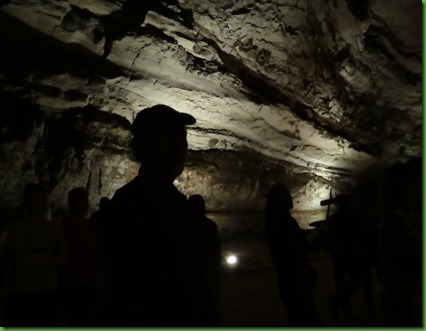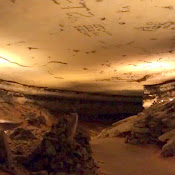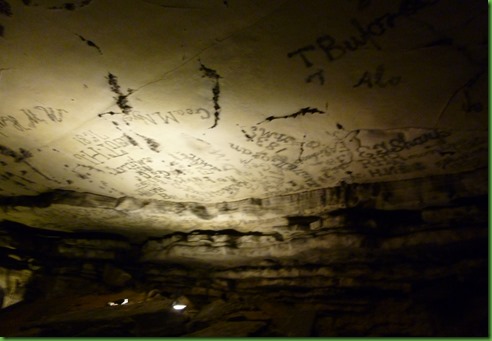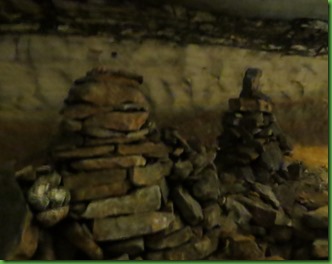Saturday September 20, 2014
Mammoth Cave National Park Campground
Mammoth Cave, Kentucky
We have only one tour scheduled for today so we bike over to the visitor center to look further at some of their exhibits. Usually we do the visitor center all at once but here we’ve been doing it in bits.
On the way over we pass by wild turkeys in the grass. Somehow wild turkeys are much more attractive and intelligent than domesticated ones. At least they are to me.
There is way too much great information in this visitor center to share it all. Today we did the geological history and there are a couple of things I thought were really interesting.
The first one was the information and map about the Karst Landscape. In a karst landscape water moves rapidly underground by dissolving rock. Limestone is a common soluble rock and karst landscapes are found throughout the United States and the world. Looking at the map you can see that Mammoth Cave’s karst landscape is part of one of this nation’s largest regions of cavernous rocks. Caves and springs commonly occur in karst regions like Kentucky, southern Missouri and Florida. See the greens on the map. Those are carbonates, limestone, dolomite and marble. Dark green is exposed and lighter is buried.
Karst is key to Mammoth Cave’s origin because rock must be readily dissolved by mildly acidic water for cave passageways to form. What Mammoth Cave has that some other karst caves lack is an insoluble sandstone roof. Sandstone protects the rocks below it.
The other thing of particular interest to me on the map is the red. Those are the volcanic areas.
The exhibits are very attractively arranged and presented. One section discusses this area geologically from the time before it was land. The map shows the location of the equator330 million years ago. You have to look carefully to see the various underlying state and Canadian provinces. Amazing that Kentucky was quite far south of the Equator which went through North and South Dakota.
Today we are taking the Gothic Avenue tour which, like all tours, begins at a Shelter outside the Visitor Center. We walk down the hill and enter the Historic Entrance. I think this is everyone’s favorite entrance, I know it is mine.
This tour is large, 40 people, and three guides. Only one is presenting the tour however. I’m not sure what the other two guides are for until we are midway through the tour and retracing our steps.
Coming in this entrance means that we again descend down quite a few steps and into the cave. Once past the locking gate, as before, we walk down a slight slope into what is called the “Rotunda” which is a large cavern room, covering about 1/4 acre and about 150 feet below the surface with a circular ceiling giving it the “Rotunda” effect.
Within the Rotunda are the remains of the saltpeter mines, all perfectly preserved. Saltpeter, used in the making of gun powder, was mined in the cave by slaves and production was at its peak during the War of 1812 as the British had blockaded our other sources of this material.
We see the boxes into which the soil was deposited when it was dug out of the cave floor. Tulip Poplar tree trunks were hollowed out to make “pipes” that were used to pipe-in the water necessary to leach the saltpeter out of the soil, and to pipe-out the saltpeter “beer” for further processing. One end of a pipe was tapered and fitted into the blunt end of the next pipe and sealed with a metal band. I have discussed this information in a previous post on our first tour here. If you are interested you can find it here.
Because of that and the larger size of the group, I didn’t take very many pictures. I was listening closely to see what if any new information was provided. In fact, I didn’t take many pictures at any point in the tour thinking I would take them on our way out when most of the information had been already been presented and I would be able to be at the back of the tour group rather than at the front. Since the guide talks as he goes along, if you are in the back you miss all the incidental conversion and information. You only hear what he says when he stops.
Once we leave the Rotunda, we continue on what is called Broadway, climbing more stairs, walking up slopes and passing by more saltpeter mining areas.
Eventually we come to a lit stairway which we descend into the area known as the Methodist Church. It is called this because in the 1800′s, church services were performed in this section of the cave. It has its own natural air conditioning and the chamber is very wide and tall with a natural stone “pulpit”.
Our guide gives us the new information that even now, on the first Sunday in December, musical performances are held in the church chamber which are free and open to the public. Wouldn’t that be fabulous? To hear a choir in this large chamber?
From this chamber there is a pathway to the right and another set of stairs going up. We did not take these on our last tour and it is the reason we have taken this one. At the top of the stairs and off to the right is rock overlook known as “Booth’s Amphitheater” where supposedly actor Edwin Booth (brother to John Wilkes) once recited the soliloquy from Hamlet to cave visitors.
These stairs lead to the Gothic Avenue where there is a lot of historic graffiti. As I discussed in the earlier post , prior to 1941 when Mammoth Cave became part of the National Park system, the cave had been privately owned.
As early as 1816, as the need for saltpeter mining “petered out” (and that is supposedly where the saying came from), the cave was marketed as an attraction and played a major role in the start of tourism. In an attempt to get more tips, the guides, for a fee, would “smoke-write” their visitors names on the ceilings and rock walls of the cave using the soot from tallow candles attached to the end of a long stick. The ceilings in the beginning of this section are fairly low, making this rather easy to do. They get taller and taller as we go and assumedly those names are later in time.
One famous guide was Stephen Bishop, a self-educated enslaved person, became a legendary cave guide and explorer. He began guiding visitors at age 17 in 1838. Another guide was George S. Gatewood whose name or initials can be seen in several places in the ceiling. Interestingly, many of the names have the lettering backwards like a mirror image – the theory is that mirrors were placed on the floor of the cave and used to relieve the neck strain of this tedious process of smoke writing. Thus the reversed images. It was fun looking at the names and especially finding dates from the 1830’s.
Eventually the owners decided the cave was becoming too covered in sooty names and determined that the candle writing had to stop. Now the guides needed another way to earn those tips. In addition to guiding, their duties included clearing new paths by picking up rocks and putting them aside. Clever like Tom Sawyer, they tricked tourists into cleaning up the paths by suggesting they pick up the stones and build monuments to their states or companies or anything they wanted. Often plaques were put on the top of the monument. One very funny story was that of the Kentucky Monument. If anyone from another state built his monument up to the ceiling, the guides would come back later and make it a little bit shorter so the only monument to the ceiling is still Kentucky’s. All of these remain from over 100 years ago.
In one area, our guide points out that the dark stripes in the rock are gypsum. Normally gypsum is white but in parts of the cave, the gypsum has turned black because it readily absorbs the soot of torches, oil lamps and candles.
From the artifacts that have been found it is known that the natives mined the gypsum but they are not sure why, perhaps for paint. He also pointed out that obviously gypsum (calcium sulfate) is used for wallboard but that humans consume about 12 pounds in a year since it is added to many food products such as tofu, beer, baked goods, cereals, etc. because it acts as a preservative, anti-caking agent and anti-foaming agent. I read a lot of labels and don’t think I’ve ever seen gypsum listed as an ingredient but calcium sulfate quite possibly. Not sure how I feel about that.
Gothic Avenue has a number of columns. Because this area of the cave is dry I’m not sure how they came to be here given the cap stone outside on top of the cave..
We are walking back down Gothic Avenue. It’s great to see it a second time from a different direction.
We arrive back in the Cathedral and take the lighted stairway back up to the main tunnel into the Rotunda. When we turn around I go to the back of the group to get the pictures on the way out but the other two guides are really pushing us along and are actually making it uncomfortable to take photographs. I’ve never had this happen on a National Park tour before. Good thing David took his in the first place. The majority of what you are seeing are his.
Despite the rather hurried ending, I have still enjoyed seeing the Rotunda and the Church again and most especially Gothic Avenue, which is one of the most historically significant passageways in the cave. It has been amazing to walk among hundreds of examples of visitor experiences still visible today, from the multitude of nineteenth-century candle-written signatures to the dozens and dozens of stone monuments left behind by visitors so long ago.





























Evocative and mysterious. I find myself wondering what Shakespeare would have made of portions of Hamlet being recited in a cave that would have been unknown in his day.... by the brother of an assassin.
ReplyDeleteBeautiful shots!
These interesting little side stories of the cave's history makes it come so alive. Thanks for another interesting blog, you sure know how to find the most amazing details! :c)
ReplyDeleteCandle writing seems rather tedious but brilliant idea to have the visitors pick up the rocks in the trail. 40 people is a big tour and I'm sure that's why the extra guides. Unless there was a program audit going on. I only led 16 and always had those at the end that wanted to linger for photos but there is a time schedule to keep.
ReplyDeleteHope everything is going OK at home now.
You might drive some of the guides crazy if they have a schedule to keep! It's great to find so much of interest on a tour - I usually enjoy parts of it much more than others.
ReplyDeleteI meant to add a smiley :-) to my comment. Hope you hear the smile in my words..
ReplyDeleteThe dry parts of the cave are 'dead' now, but in the past it was wet (that's how it was formed...) and as the water level dropped it went from active water to dripping water to dry. I was a caver in that area from high school until about 10 years ago and have had the honor of going on scientific trips to the parts that most of the public will never see. Facinating cave.
ReplyDeleteWhat an interesting cave system! This cave has it all. Each of your tours was so different. I like the idea of the rock monuments and the smoke writing. While smoke writing was graffiti, it was so well done! Glad you were able to enjoy so many of the tours:)
ReplyDeleteSo that's where the expression "petered out" comes from! I like knowing the origin of words and sayings. :-)
ReplyDeleteWOW... not just a cave tour but an interesting history lesson!!! Definitely have to put Mammoth Cave Tours on our REDO list;o))
ReplyDeleteYou've taken some really good pictures in those caves. I have a lot of trouble with that. Guess I'mm too lazy to read about how to do it! Thanks for the tour.
ReplyDeleteWe may be close enough to actually make time to go here in our days off. Thanks for the tour!
ReplyDeleteInteresting- Can you imagine how smokey that cave was with all the guides carrying tallow candles- probably did not smell to good either :)
ReplyDeleteThanks for the stories ... they make looking at the photos that much more interesting.
ReplyDeleteI LOVE this cave walking through these huge cavernous passages while hearing stories from its long history. Always fun for me, and you really did a great story on this tour!
ReplyDeleteThose old tour guides were smart cookies! Not only did they get tips and the paths cleared, but left a great legacy to the cave system. The cave photos are wonderfully eerie (a few days before Halloween at that). Love the big map at the VC, interesting to know the different geological areas in the country. Hope you and David are both doing well - fall must be gorgeous at the farm.
ReplyDeleteYou are taking me places that I would never go .... spoooookay! but fascinating ... love all the stories and information ...
ReplyDeleteWe missed another tour. But in a way your pictures and stories are better told, very interesting. Not sure if I would go to church there :)
ReplyDeleteI recall singing in the cave in 1990 but not all the signatures. A choral concert would be amazing! Maybe I remember the monuments to the states...very interesting history and detail about the rocks. Fun tour even if it was rushed at the end...
ReplyDelete